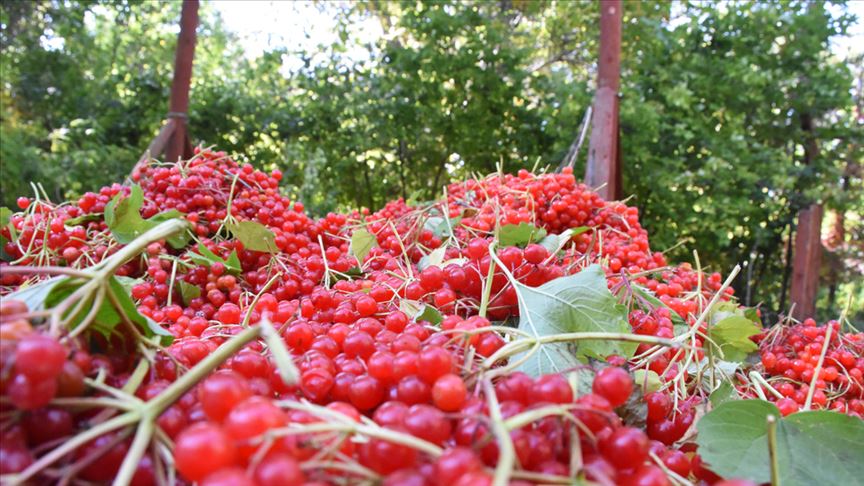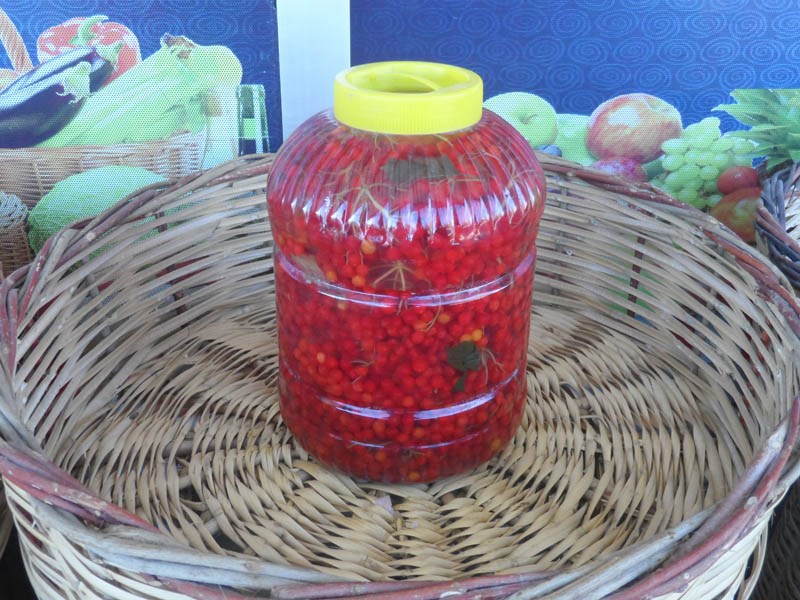Bünyan Gilaburusu is a product registered as a designation of origin (menşe adı), grown within the geographical boundaries of the Bünyan District of Kayseri Province. The product's Latin name is Viburnum opulus, and it is a wild fruit found naturally in Anatolia. An application was made for Bünyan Gilaburusu on February 16, 2017, and it was registered in the name of the Bünyan Municipality Presidency on October 22, 2018.
Gilaburu is defined worldwide as a multi-branched shrub species that can reach 2 to 5 meters in height. Due to its white flowers, it is also known as the "snowball bush" in English-speaking regions. The Turkish word "gilabolu" comes from the Latin-origin word "globule," meaning a small, round, spherical pellet. In Turkey, it is cultivated significantly in the Bünyan, Akkışla, and Gesi regions of Kayseri.

Bünyan Gilaburusu (Anadolu Ajansı)
Distinctive Characteristics
The gilaburu grown in Bünyan is juicier, larger-berried, and more red in color compared to species in other regions. These differences are closely related to the climate and geographical conditions of the Bünyan District of Kayseri Province.
Physical and Yield Characteristics
- The trees are generally shrub-like in appearance, being small trees that reach heights of 3.5 to 4.5 meters.
- They begin to bear fruit 3 to 4 years after planting, and the yield per tree is approximately 15–25 kg.
- The fruit juice yield is around 60–70%, which is a higher rate than that of Gemerek and Akkışla gilaburus.
- The fruits are spherical in shape and form in clusters (demet). Each cluster contains approximately 35–50 fruits.
- The diameter of Bünyan Gilaburusu has been measured as 8.5–9 mm, its weight as 0.72 g, and its density as 0.0416 g/cm³.
Fruit and Tree Structure
- The leaves are oppositely arranged, 3–5 lobed palmate in shape, and their edges are irregularly toothed. The dark green leaves turn red in autumn.
- The flower shape is a compound umbel; thanks to its showy white flowers, bright red fruits, and leaves that turn red in autumn, it is also cultivated as an ornamental plant.
- The fruit has a single seed; the seed is disc-shaped and white in color. When the fruit is fully ripe, it is bright red, odorless, and tasteless.
- When the fruit ripens, it has a bitterish-sourish taste.
Climate and Soil Relationship
The Bünyan region is under the influence of a continental climate; summers are hot and dry, winters are cold and harsh.
- Chilling Requirement: For gilaburu plants to be productive, the average air temperature must drop below -10 °C, especially in December, January, and February, and they must spend a period below certain low-temperature values.
- Aroma, Color, and Taste: During the fruit ripening period (August-October), the average temperature being around 25-30 °C is effective in the formation of the fruit's aroma. The district's high altitude and the large day-night temperature difference (night: 5 °C – day: 25-30 °C) positively affect the fruit color becoming redder and the formation of its aroma, taste, and sour-bitterness.
- Soil Characteristics: Bünyan Gilaburusu grows mostly wild, on the borders of irrigated agricultural lands and along stream banks (dere kenarları). The soil has a clay-loam (killi tınlı) structure, is slightly alkaline (pH 7.72), very calcareous (kireçli) ($CaCO_3$ amount 49–50%), and has a high organic matter ratio (4.47–4.57%).
Cultivation and Production Method
Gilaburu does not exhibit periodicity (peryodisite) and generally has a stable yield process.
- Propagation and Planting: Shoots (şıvgınlar) cut during pruning and suckers (sürgünler) formed from their roots are used in cultivation. Soil cultivation for planting operations is done in March-April. Saplings (fidanlar) are marked at 2.5 – 3 meter intervals and planted in 50 cm deep pits (çukurlar) with soil mixed with organic manure.
- Irrigation and Maintenance: In the first year of development, the root zone is kept moist. Irrigation is done by flood irrigation (salma su) where suitable, and by drip method (damlama usulü) where not suitable. Abundant irrigation is done between June and September.
- Fertilization: After plowing (sürümden sonra) in autumn, $2.5-3 \text{ tons/da}$ of organic manure should be applied and mixed into the soil.
- Harvest: The fruits ripen on October 8. The determination of the harvest time is based on the fruit color being dark red, the fruit firmness (sertliğinin) softening, the size being 8.5-9 mm in diameter, and the aroma having a bitterish-sourish taste. Harvesting is done by hand-picking the gilaburus, which are in clusters, one by one.
Usage and Preservation Method
The most common use of Bünyan Gilaburusu is its fruit juice. After the fruits are picked, 3 liters of drinking water are added to 2.5 kg of fruit in 5-liter containers, and they are kept in water for at least 1.5–2 months. Provided it is stored in water (water temperature must be between 0-15°C) in a cool place out of the sun, it can maintain its freshness for 10–11 months.

Gilaburu Fruit Juice (Bünyan Kaymakamlığı)


